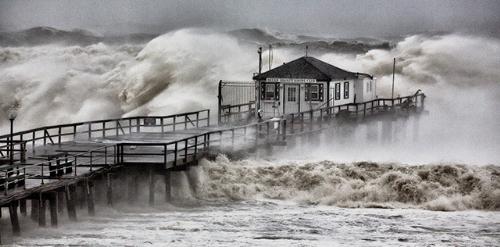
Superstorm Sandy battered the New York metropolitan region nearly two years ago, killing 60 people and piling up an estimated $65 billion in damages. (PRNewsFoto/Lincoln Institute of Land Policy)
CAMBRIDGE, Mass., April 25, 2014 (Korea Bizwire) – While Korea has displayed a collective failure when it comes to crisis management systems encountered by the tragic ferry sinking accident, the US seems to have learned a valuable lesson from its previous natural disaster and is on a path to better equip itself with more “resilient” systems when it face the similar situations in the future.
A report released today by the Lincoln Institute of Land Policy recommends a new federal framework for disaster recovery that will make coastal regions more resilient in the decades ahead, saving billions in the process.
Lessons from Sandy: Federal Policies to Build Climate-Resilient Coastal Regions, co-authored by Robert Pirani and Laura Tolkoff of the Regional Plan Association, was announced today at RPA’s Regional Assembly in New York.
”It is clear that our coastal communities cannot just simply rebuild after climate events like Superstorm Sandy. They must rebuild smarter and stronger,” said Armando Carbonell, senior fellow and chairman of the Department of Planning and Urban Form at the Lincoln Institute. “Federal policies must be re-aligned to ensure that resilience is part and parcel of recovery efforts.”
The report recommends a series of necessary changes in disaster recovery, recalibrating the process of funding relief and recovery efforts, modifying regulations, and putting incentives in place to encourage better adaptation to the inevitable impacts of climate change — volatile weather, sea level rise, and storm surge. Greater resilience must be built into the repair of vital transportation and energy infrastructure in particular, the report says.
A new approach to rebuilding that addresses both short-term needs and long-range planning will require changes across the board in disaster recovery, from the National Flood Insurance Program to the Federal Emergency Management Agency to the work of the US Army Corps of Engineers – all in coordination with state and local governments. The report also calls for more clarity about how National Environmental Protection Act and other environmental standards and reviews apply to recovery efforts.
The authors of the report examined the relief and recovery efforts following Superstorm Sandy, which made landfall in Brigantine, New Jersey, on October 29, 2012, inundating key infrastructure, disabling power plants and transmission lines, and leaving 4.5 million in three states without electricity. The storm surge easily overtopped protective dunes and floodwalls from Atlantic City to New London, damaging more than 600,000 homes and killing 60 people. Estimated damage topped $65 billion.
As the wakeup call that elevated the discussion about disasters and climate change at all levels of government, Sandy made it clear that current recovery strategies, urban planning, and coastal management practices were no longer viable; in the face of rising sea levels, these outdated approaches undermine riverine and coastal ecosystems, endangering people, property, and regional economies that represent a significant portion of national GDP.
Lessons from Sandy defines resilience as the capacity to recover quickly from shocks and stressors while at the same time reducing future risk. By strengthening and integrating this connection between disaster recovery and rebuilding—between short-term and long-range actions following a disaster— coastal regions gain further critical opportunities to build even greater resilience.
The report identifies a set of policies, regulations, and administrative practices that federal agencies can adopt to help coastal metropolitan areas become more resilient. In addition, the research documents how state and local governments recovering from Hurricane Sandy sought to use federal aid to create a more resilient region, and it describes the obstacles they encountered.
The authors establish why coastal regions matter and warrant stronger support from federal policies, for a more integrated approach to managing our nation’s coastal resources. They recommend reforms to existing policies, regulations, and administrative procedures that could make disaster recovery aid more flexible and supportive of climate adaptation.
Without such reforms, it will be difficult for cities and their regions to adapt to climate change and for the federal government to reduce its fiscal exposure in the face of extreme weather events.
 In examining federal flood insurance and risk management approaches, the authors detail reforms and incentives to help regions appropriately regulate vulnerable coastal areas while sustaining them as attractive places to live and do business.
In examining federal flood insurance and risk management approaches, the authors detail reforms and incentives to help regions appropriately regulate vulnerable coastal areas while sustaining them as attractive places to live and do business.
On the subject of local and state coordination, the authors found that adaptation can be integrated into funding programs and federal planning activities that influence infrastructure investments, with a focus on major federal expenditures that either shape physical regions or have broad impacts on state and local land use decisions.
The report also includes a section describing the science, information, and planning tools that facilitate more adaptive planning and policymaking —particularly data-driven support tools that can help leaders make decisions in the face of uncertainty.
The specific policy recommendations to position federal agencies to help coastal regions adapt to a changing climate, aimed at advancing a national strategy for disaster recovery, include:
Anticipate future climate impacts during the disaster recovery and rebuilding processes:
- Adjust the rules that govern the use of disaster relief aid to help communities not only rebuild, but rebuild in a more resilient way.
- Evaluate projects on their true costs and risks, including life cycle costs and environmental impacts.
- Strengthen connections between pre- disaster and post-disaster planning efforts, in part by enforcing Executive Orders that protect and restore ecological systems.
- Develop new financing and insurance models that capture the value created through mitigation to support long- term investments in resilience.
Align federal policies and programs to reduce risk and restore the health and productivity of coastal resources over the long term:
- Remove incentives to develop in hazardous areas.
- Create risk reduction standards for multiple hazards, base them on future climate conditions, and build in a threshold for uncertainty.
- Enforce Executive Orders that serve to protect and restore ecological resources.
Enable effective urban infrastructure and development patterns:
- Incentivize regional planning across federal grant and loan programs.
- Incentivize state and local governments to play a leadership role in risk reduction and environmental protection.
- Support strategic investments in energy resilience.
- Distribute costs and responsibility for risks fairly and help low-income households to access affordable housing in lower-risk areas.
- Reward cities for partial mitigation activities that reduce flood losses.
Develop and share data, guidance materials, and decision-support tools to help governments and property owners make forward-thinking decisions:
- Invest in science and decision-support tools to help both the public sector and the private sector make decisions that support resilience.
- Expand the use of new technologies to integrate two-way flows of information among all levels of government.
- Disseminate guidance and best practices across federal programs and use data visualization to effectively communicate risk to the public.
The Lincoln Institute of Land Policy is a leading resource for key issues concerning the use, regulation, and taxation of land. Providing high-quality education and research, the Institute strives to improve public dialogue and decisions about land policy.
About the Authors
Robert Pirani is the program director for the New York–New Jersey Harbor & Estuary Program at the Hudson River Foundation, and a senior fellow at Regional Plan Association. Prior to joining the Foundation in 2014, he was RPA’s vice president for energy and environment for more than 20 years.
Laura Tolkoff is associate planner for the Environmental and Energy Programs at Regional Plan Association, where she has focused on advancing climate mitigation and climate resilience through research, advocacy, and planning. She manages RPA’s energy program, which seeks to develop a contemporary model of energy infrastructure.
SOURCE: Lincoln Institute of Land Policy (via PRNewswire)







